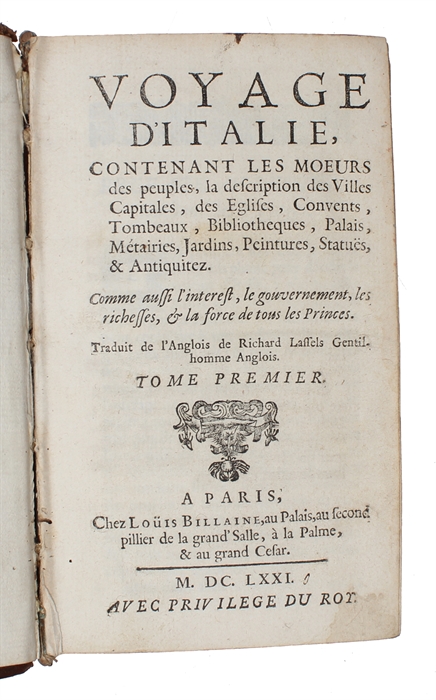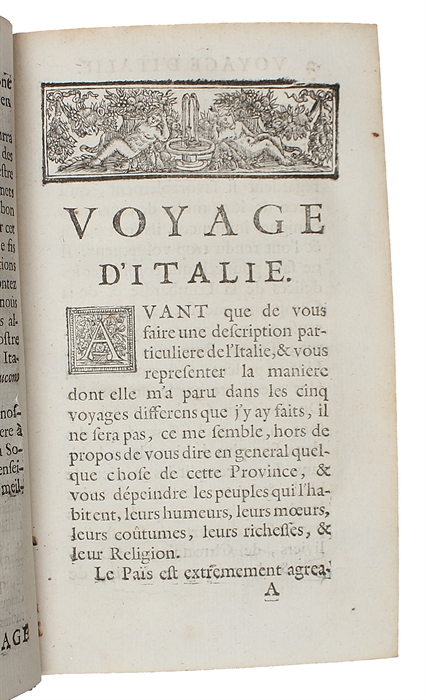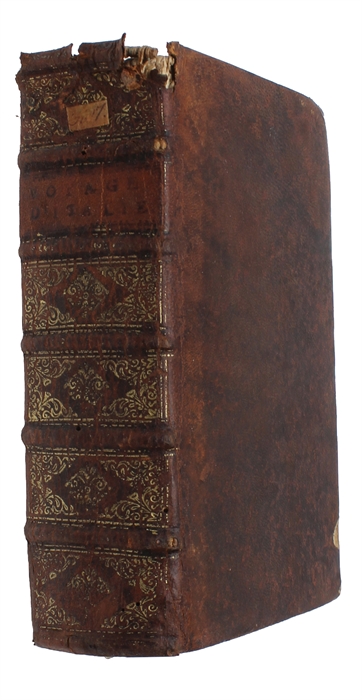THE MOST INFLUENTIAL GUIDEBOOK OF ITS DAY - COINING "GRAND TOUR"
LASSELS, RICHARD.
Voyage D'Italie, contenant les Moeurs des peuples, la description des Villes Capitales, des Eglises, Convents, Tombeaux, Bibliotheques (...). 2 vols.
Paris, Ballaine, 1671.
8vo. Two part bound in one contemporary full calf binding with five raised bandes. Wear to extremities. Upper capital chipped, with a bit of loss of leather, showing endbands. Inner front hinge split. Previous owner's name to front free end-paper. Small worm-tract to inner margin, not affecting text. (36), 436, 341 pp.
The exceedingly rare first French translation of Lassels‘ travel-guide, considered the first comprehensive guide to Italy it quickly became the most influential English guidebook of its day. The concept of the “Grand Tour” was also first introduced here. Lassels’ asserts that any truly serious student of architecture, antiquity, and the arts must travel through France and Italy, and suggested that all "young lords" make what he referred to as the Grand Tour in order to understand and learn about the political, social and economic realities of the world. “The idea of tourism as self-enriching rather than soul-preserving come truly into vogue between 16th and 18th centuries. The Grand Tour, a term first used in the French translation of a ‘Voyage or a Compleat Journey through Italy’ by Richard Lassels published in 1670, encompassed experience (including sexual), education and exchange of ideas, creating the largest and most independent wandering “academy” – a sort of finishing school – that Western civilization had ever known”. (White, Museum and Heritage Tourism). “The term ‘Grand Tour’ itself first appeared in the French translation of Richard Lassels’ Voyage or a Complete Journey Through Italy, which was published in 1670. This was one of a number of accounts of travel on the Continent, most of which were written by Englishmen, and by the early eighteenth century, there was a steady stream of such publications. The eighteenth century then saw a massive growth in the production of books, newspapers, and other printed material, and this encouraged the development of different types of writing and publishing, including travel accounts. There also emerged travel guides, the most useful of which was probably The Grand Tour containing an Exact Description of most of the Cities, Towns and Remarkable Places of Europe by Mr [Thomas] Nugent, first published in four volumes in 1743, and repeatedly republished. An alternative was The Gentleman’s Pocket Companion for Travelling into Foreign Parts, first published in 1722, which contained a list of useful phrases at the end, but not, perhaps, those which the wellbred young man should employ.” (Kathleen Burk, The Grand Tour of Europe) The most influential English guidebook of the period, conditioning the first impressions of many a tourist to that country. It also provided the basis for subsequent guidebooks . . . The unprecedented attention it paid to art and architecture encouraged the phenomenon of the eighteenth-century style 'grand tour' (a term coined by Lassels) according to which art prevailed over all other subjects, religious or secular" (ODNB). The original English edition was published in 1670. French translations were published it 1671 and 1682. A German translation titled 'Ausführliche Reise-Beschreibung durch Italien' appeared in Frankfurt editions in 1673 and 1696. It was reprinted well into the 1700ies. Provenance: A large Danish estate.
Order-nr.: 60994



